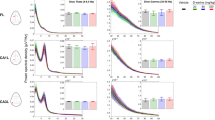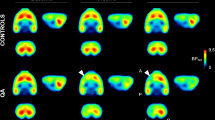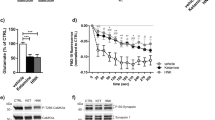Abstract
The cytokine interleukin-1β (IL-1β) has been implicated in various forms of neurodegeneration, and several lines of evidence indicate that it also modulates synaptic transmission in the central nervous system.1 Excessive release of the excitatory neurotransmitter L-glutamate results in cell death and probably mediates many neurodegenerative conditions.2 We set out to test the hypothesis that involvement of IL-1β in neurodegeneration results in some interaction with excitatory amino acid-mediated synaptic transmission in the rat striatum, either by modifying glutamate release or actions. Presynaptic effects of IL-1β and the IL-1 receptor antagonist (IL-1ra) on glutamate release and calcium entry were investigated in isolated nerve terminals (synaptosomes) prepared from the striatum. In order to evaluate the involvement of IL-1 in neuronal damage caused by glutamate receptor over-activation, the effect of IL-1ra was studied on N-methyl-D-aspartate (NMDA) and α-amino-3-hydroxy-5-methyl-4-isoxazolepropionate (AMPA) receptor-mediated brain damage in the rat striatum and cortex in vivo. Neither rat recombinant IL-1β (rrIL-1β: 0.01–2 nM) or human recombinant IL-1ra (hrIL-1ra: 0.2 μM) had any significant effect on the KCl-evoked glutamate efflux or calcium entry in striatal synaptosomes, indicating that their actions are unlikely to be presynaptic. In contrast, intrastriatal infusion of hrIL-1ra markedly inhibited (by 43–46%, P < 0.05) neuronal damage caused by striatal nmda or ampa receptor activation in the rat in vivo, whereas no effect was seen on damage induced in the cortex. Thus, our data suggest that IL-1β and IL-1ra influence neuronal damage in the striatum by acting to modify events that occur after excitatory amino acid receptor activation.
This is a preview of subscription content, access via your institution
Access options
Subscribe to this journal
Receive 12 print issues and online access
$259.00 per year
only $21.58 per issue
Buy this article
- Purchase on Springer Link
- Instant access to full article PDF
Prices may be subject to local taxes which are calculated during checkout
Similar content being viewed by others
Author information
Authors and Affiliations
Rights and permissions
About this article
Cite this article
Allan, S., Lawrence, C. & Rothwell, N. Interleukin-1β and interleukin-1 receptor antagonist do not affect glutamate release or calcium entry in rat striatal synaptosomes. Mol Psychiatry 3, 178–182 (1998). https://doi.org/10.1038/sj.mp.4000351
Received:
Revised:
Accepted:
Published:
Issue Date:
DOI: https://doi.org/10.1038/sj.mp.4000351
Keywords
This article is cited by
-
The meteorology of cytokine storms, and the clinical usefulness of this knowledge
Seminars in Immunopathology (2017)
-
Anti-inflammatory effect by lentiviral-mediated overexpression of IL-10 or IL-1 receptor antagonist in rat glial cells and macrophages
Gene Therapy (2010)
-
Effect of interleukin-1β on NMDA-induced 45Ca2+ uptake by synaptosomes of rat brain cortex
Bulletin of Experimental Biology and Medicine (2005)



